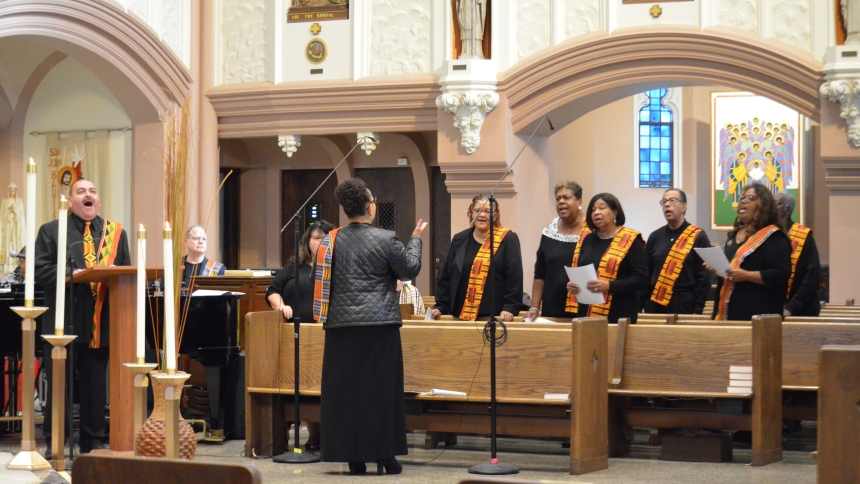
GARY– Throughout the first 2,000 years of the Catholic Church, faithful men and women from Africa and the African Diaspora have been both foundational and pioneering in the Catholic faith. Members of the Diocese of Gary honored this part of Catholic history as they gathered on Nov. 19 at the Cathedral of the Holy Angels.
A combined choir of Holy Angels and Ss. Monica and Luke added to the special liturgy held during Black Catholic History Month. Hector Arroyo and Beth Moreno treated those gathered to solos of “We are Sharing” and “Deep River” prior to the start of Mass presided by Bishop Robert J. McClory and concelebrated by Father Michael Surufka, OFM. Deacons Mikinson “Mickey” Henry, Martin Brown, Tom Kubik and Michael Halas assisted during the service.
Bishop McClory started his homily by reflecting on Presentation Our Lady of Victory in Detroit where he served as pastor for six years. The parish, he explained, had a unique, determined, and in some ways, a painful history in the 1930s and early 1940s.
During that time, within the city of Detroit, an 8-foot wall was built. The wall marked where the Whites were to live and where the Blacks were to live. In the midst of this era, Anna “Madre” Bates, a woman of color who had immigrated from Bermuda, found it intolerable that there was not a church for her and other Black Catholics. With perseverance, she lobbied the local bishop to establish one in the community until Our Lady of Victory was founded in 1943.
Bishop McClory shared that the parish recently celebrated its 80-year history by hosting a large gathering. He said the church wanted to continue to share the story of Madre Bates and celebrate the parish’s heritage that was started with an initial desire and expression and fulfillment of a church that could meet their needs and serve in the midst of the heavily segregated situation.
“How beautiful was the gift of this parish that the legacy continues to this day, and I was privileged to be part of the hearing of those who took such great advantage of the talents they were given to serve the Lord,” he said.
Bishop McClory continued stating that Black Catholic History Month, which he pointed out is also within the same month as All Saints Day and All Souls Day, is a time to remember heroes, saints and others who have come before and “ask them to pray for us, that we would imitate their virtues and that we would call upon their intercession before our Lord.”
“The great contributions of Black Catholics of the United States and more widely African Catholics in the diaspora spread throughout the world is remarkable,” he said.
Bishop McClory specifically mentioned a few by name including Augustus Tolton, the first known Black Catholic priest in the United States, and Julia Greeley, a slave who became a Secular Franciscan and helped those in poverty in Denver during a period of intense racism.
“They knew the treasures they had, they knew what the Lord had given them, they knew they had a plan in their lives, and they weren’t going to be deterred from serving,” he said. “They went and unburied their treasure and multiplied it tremendously.”
“Don’t let your treasure be buried,” the bishop added, addressing the congregation. “Make sure it’s unearthed and all those talents that are given are used for the greater glory of God.”
Following the Mass, those in attendance were invited to learn more about Black Catholic history by reading facts that were provided in the program and viewing the display “Voices of Our People Past and Present” that was set up in the adjacent gymnasium.
The Voices Project began as the dream of the late Anita Miller, a long-time catechist and director of religious education at Ss. Monica and Luke and Deacon Martin J. Brown. The purpose of the project is to document the contributions of the people of Africa and the African Diaspora and create a traveling exhibit that would bring to life the voices of ancestors who lived and died in service to the Lord.
Deacon Brown said all the information he found was readily available but required searching for the information among books, some of which were out of print, and looking deeper into references listed online on Wikipedia. He said he hopes the display, which continues to grow, gives people “the knowledge of what’s there.”
“You have all kinds of people shown there – you have people from Europe, white bishops from America,” he said. “It’s not just people from Africa and the African Diaspora but it’s a story, the story of Catholicism.”
Gerly Pressley, of Gary, took the opportunity to look over the display on what was her first visit to the cathedral. She moved to the city three years ago and wanted to attend a Catholic service and was finally able to with some transportation assistance from her son Scott.
“It was beautiful,” she said of the liturgy. “And I really appreciate that amidst the storms we don’t stop. The faith lives on. That’s what brought me here – the faith.”
Megan Henry, the wife of Deacon Mickey Henry, called the music performed by the choirs of Holy Angels and Ss. Monica and Luke during the Mass inspirational. She came looking forward to being able to view The Voices Project.
“You don’t hear enough about the history and it’s interesting,” she said. “I wanted to see (the exhibit) when it was set up at Bishop Noll, but I didn’t get to because I was at a conference, so I am happy I get to see it now.”
A list of over 900 named Catholic saints from Africa and the African Diaspora and a list of over 600 notable Black Catholics can be found at voicesproject.net. The project is scheduled to be at Bishop Noll Institute in Hammond, for the second time, during Black History Month in February 2024.
